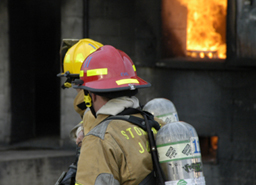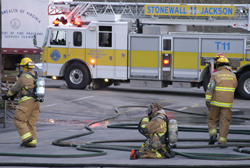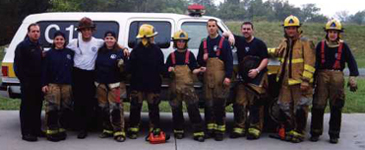|
Firefighting is physically and mentally demanding work. To accomplish the firefighting mission successfully, SHVFD firefighters and fire officers complete rigorous training programs, both at the academy and in-house.
Red Hat
 Firefighter training begins in the station. New members are required to go through some basic fireground training before they are allowed to ride the apparatus, even as an observer. This initial, basic training is called "red hat" training. Firefighter training begins in the station. New members are required to go through some basic fireground training before they are allowed to ride the apparatus, even as an observer. This initial, basic training is called "red hat" training.
The red hat training covers fire hoses, ladders, protective clothing, ropes and knots, and other basic fireground operations. The emphasis is on safety. When the new member has successfully completed the red hat manual exam, three additional courses are required before the member can begin riding the apparatus as a red hat. These courses are CPR for the healthcare provider, hazardous materials for the first responder and a course in infection control.
The Academy

After becoming a Red Hat, members begin formal firefighter training at the Prince William County Public Safety Academy, in Nokesville, VA. Most classes are held two evenings a week and one day on the weekend. The academy has a large burn building which allows live fire exercises for realistic training. Classes are a combination of lectures in the classroom and practical, hands-on skill testing under the direction of some of Prince William County's most experienced fire instructors.
Firefighter I
Firefighter I teaches the basics of firefighting including equipment use, fire behavior, ladders, extrication, rescue, ventilation and safety. One full day is devoted to automotive firefighting, and two days are devoted to rescue scenarios. Near the end of the course, two days are is spent working through the burn building, in live fire exercises. During these structure fire days, crews will face six or seven real house fires in an eight-hour shift.
Firefighter II
 If you thought that was tough, wait until you get to the Firefighter II course. The Firefighter II course teaches more advanced skills, some basic command decision making and many more structure fire scenarios. Firefighter II includes another day of structural firefighting, including standpipe evolutions and interior attacks with large diameter attack lines If you thought that was tough, wait until you get to the Firefighter II course. The Firefighter II course teaches more advanced skills, some basic command decision making and many more structure fire scenarios. Firefighter II includes another day of structural firefighting, including standpipe evolutions and interior attacks with large diameter attack lines
Instructor I, II & III
Instructor I helps experienced firefighters become better instructors by teaching how to teach. The course teaches teaching techniques and then requires each student to give a fire department-related presentation as part of the final exam. Instructor II & III teach how to create lesson plans and how to put together a course outline to teach classes within the fire service.
HazMat
With interstate highways, railways and hazardous material processing and storage in the county, HazMat training in a must. Hazardous Materials management is taught to a variety of levels including HazMat Awareness, which teaches identification and evaluation of hazardous materials; HazMat Operations which covers containment and mitigation of hazardous materials and gross decontamination; And finally, HazMat Technician which is the most advanced level of hazardous materials training. Extensive training in supervising a hazardous materials incident and dealing with extremely difficult hazardous materials situations is conducted during the Technician level course.
Officer I, II and III
Fire service leaders require education as well. The Officer series teaches incident command, fire attack strategy and tactics, fire investigation, management, administration, human resources and other related disciplines.
Emergency Vehicle Operator Course III & IV
Driving a fire truck isn't quite like driving your average car, or even a large SUV. It takes special skills to handle a heavy emergency vehicle in traffic and under stressful conditions. To this end, driver candidates are certified in EVOC, and for fire apparatus, that typically includes class III (Pumpers and Trucks) or IV (Tractor-Trailer).
Most of these classes are available at the Prince William County Fire Academy, but Stone House VFD&RS will often send members to other institutions, like the National Fire Academy, for advanced training.
| 
